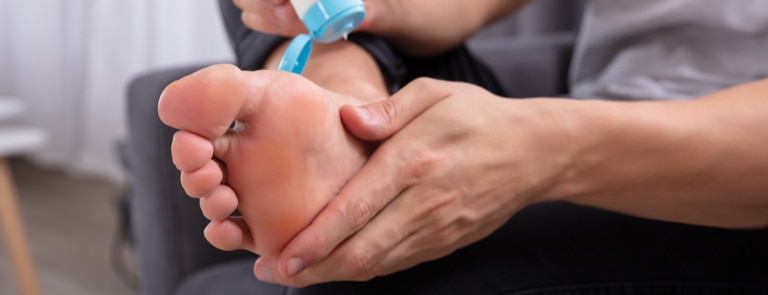10% off £35
What is athlete’s foot?

Athlete’s foot is an irritating fungal infection, which, although uncomfortable and unpleasant, puts sufferers among good company – sporting stars frequently suffer from this condition.
What is athlete’s foot?
The medical name for athlete’s foot is tinea pedis, which describes the infectious fungus that causes the condition. Although most commonly found on the feet, athlete’s foot can also infect the hands and nails.
Causes of athlete’s foot
Athlete’s foot develops after sufferers come into contact with an infected person or surface. The fungus flourishes in moist environments, like shower blocks, gym locker rooms, swimming pool floors, and sweaty socks.
Unfortunately, developing athlete’s foot becomes more likely as we age, due to a combination of factors. These include reduced mobility which makes it more challenging to clean feet well and a weakened immune system.1
Symptoms of athlete’s foot
The most common symptoms of athlete’s foot include:
- Irritated white patches between toes
- Skin flaking, redness, and pain
- Cracked, bleeding skin
- Itchy blisters
- Splintering, yellow toenails
- Dry skin
- Bad smell from feet
How to prevent athlete’s foot
The first line of defence against athlete’s foot is good foot hygiene.
The best way to treat athlete’s foot is to:
-
Practice good foot hygiene
Clean your feet well every day, including between the toes.2
-
Dry feet thoroughly after washing
The fungus thrives in moist conditions. Halt its development by drying your feet thoroughly after each wash. Make sure to dry well between the toes especially, and pat dry instead of rubbing, so as not to further irritate any infected area.3
-
Have a separate towel for your feet
Stop athlete’s foot spreading to other parts of your body by reserving a towel to dry your feet with, which you wash frequently.4
-
Change shoes regularly
If you suffer from an athlete’s foot, you should own at least two pairs of shoes to wear on alternate days. Giving them time to breathe can stop the fungus living inside them.5
-
Change your socks every day
Put on a fresh, clean pair of socks each day.6
-
Go barefoot when you can
Let your feet breathe by going without shoes at home.7
How to get rid of athlete’s foot
The NHS advise that athlete’s foot is unlikely to disappear on its own. You should visit a pharmacist to find a suitable athlete’s foot treatment.
Usually, a pharmacist will advise you try an over-the-counter antifungal medication. Antifungal medicines either kill the fungus or stop it proliferating.8 In most cases, the treatment will work after a couple of weeks.9
Types of antifungal medications include:
- Creams
- Gels
- Ointments
- Tablets
Common names for treatments include10:
- Clotrimazole
- Econazole
- Miconazole
- Terbinafine
- Fluconazole
- Ketoconazole
- Amphotericin
Suppose over the counter medications fail to resolve your athlete’s foot after a couple of weeks of treatments. In that case, you should visit your GP, who may prescribe11:
- Nail lacquers, like Loceryl or Trosyl
- Tablets, including Lamisil or Sporanox
- A combination of lacquers and tablets
Last updated: 8 April 2021
- http://www.rdash.nhs.uk/wp-content/uploads/2014/02/Athletes-foot-leaflet.pdf
- https://www.health.harvard.edu/a_to_z/athletes-foot-tinea-pedis-a-to-z
- https://www.nhs.uk/conditions/athletes-foot/
- https://www.wentworthmedical.nhs.uk/syndication/conditions/athletes-foot
- http://oxleas.nhs.uk/site-media/cms-downloads/Athletes_Foot_Ud9gwlh.pdf
- https://www.nhs.uk/conditions/athletes-foot/
- https://www.nhs.uk/conditions/athletes-foot/
- https://www.nhs.uk/conditions/antifungal-medicines/
- https://www.nhs.uk/conditions/athletes-foot/
- https://www.nhs.uk/conditions/antifungal-medicines/
- https://www.rdash.nhs.uk/wp-content/uploads/2014/02/Athletes-foot-leaflet.pdf














